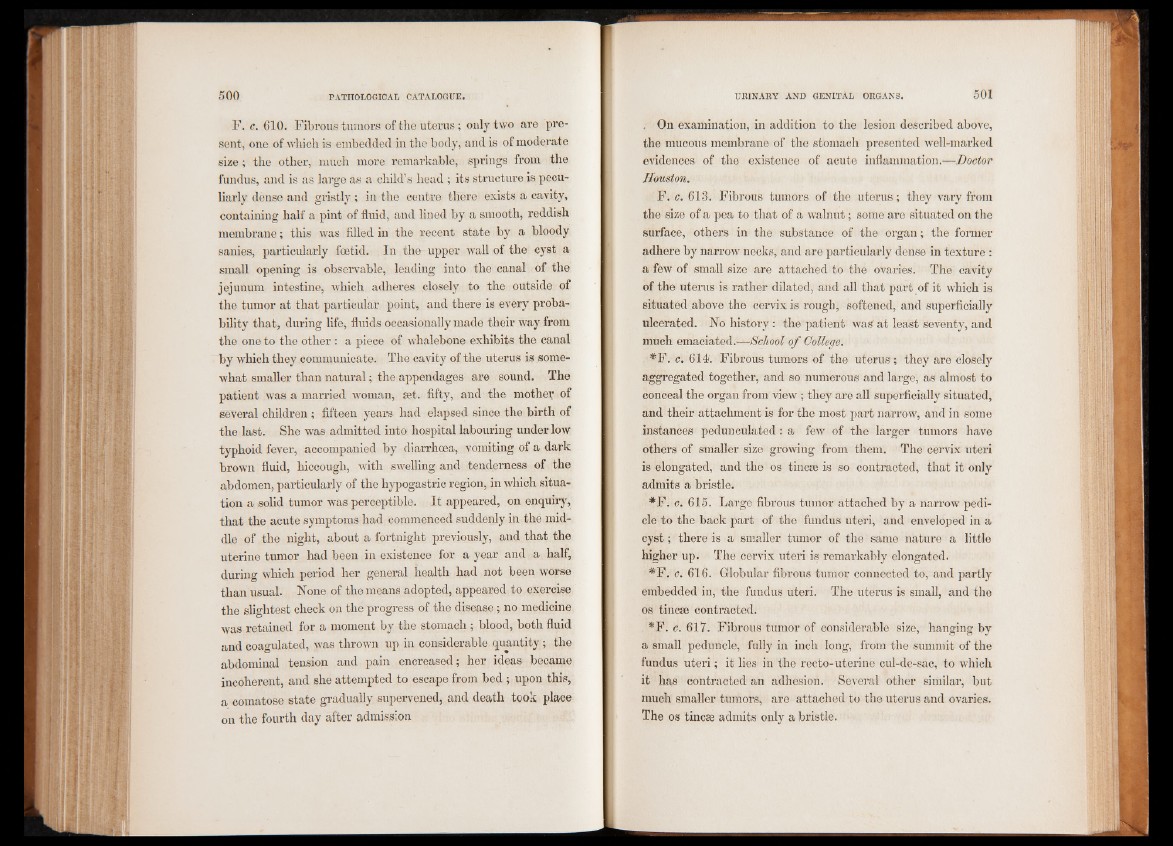
F. c. 610. Fibrous tumors of the uterus; only two are present,
one of which is embedded in the body, and is of moderate
size ; the other, much more remarkable, springs from the
fundus, and is as large as a child’s head ; its structure is peculiarly
dense and gristly ; in the centre there exists a cavity,
containing half a pint of fluid, and lined by a smooth, reddish
membrane; this was filled in the recent state by a bloody
sanies, particularly foetid. In the upper wall of the cyst a
small opening is observable, leading into the canal of the
jejunum intestine, which adheres closely to the outside of
the tumor at that particular point, and there is every probability
that, during life, fluids occasionally made their way from
the one to the other : a piece of whalebone exhibits the canal
by which they communicate. The cavity of the uterus is somewhat
smaller than natural; the appendages are sound. The
patient was a married woman, set. fifty, and the mother of
several children ; fifteen years had elapsed since the birth of
the last. She was admitted into hospital labouring under low
typhoid fever, accompanied by diarrhoea, vomiting of a dark
brown fluid, hiccough, with swelling and tenderness of the
abdomen, particularly of the hypogastric region, in which situation
a solid tumor was perceptible. It appeared, on enquiry',
that the acute symptoms had commenced suddenly in the middle
of the night, about a fortnight previously, and that the
uterine tumor had been in existence for a year and a half,
during which period her general health had not been worse
than usual. None of the means adopted, appeared to exercise
the slightest check on the progress of the disease; no medicine
was retained for a moment by the stomach ; blood, both fluid
and coagulated, was thrown up in considerable quantity; the
abdominal tension and pain encreased; her ideas became
incoherent, and she attempted to escape from bed; upon this,
a comatose state gradually supervened, and death took place
on the fourth day after admission
. On examination, in addition to the lesion described above,
the mucous membrane of the stomach presented well-marked
evidences of the existence of acute inflammation.—Doctor
Houston.
F. c. 613. Fibrous tumors of the uterus; they vary from
the size of a pea to that of a walnut; some are situated on the
surface, others in the substance of the organ; the former
adhere by narrow necks, and are particularly dense in texture :
a few of small size are attached to the ovaries. The cavity
of the uterus is rather dilated, and all that part of it which is
situated above the cervix is rough, softened, and superficially
ulcerated. No history : the patient wak at least seventy, and
much emaciated.-—School of College.
#F. c. 614. Fibrous tumors of the uterus ; they are closely
aggregated together, and so numerous and large, as almost to
conceal the organ from view ; they are all superficially situated,
and their attachment is for the most part narrow, and in some
instances pedunculated: a few of the larger tumors have
others of smaller size growing from them. The cervix uteri
is elongated, and the os tincse is so contracted, that it only
admits a bristle.
*F. c. 615. Large fibrous tumor attached by a narrow pedicle
to the back part of the fundus uteri, and enveloped in a
cyst; there is a smaller tumor of the same nature a little
higher up. The cervix uteri is remarkably elongated.
#F. c. 616. Globular fibrous tumor connected to, and partly
embedded in, the fundus uteri. The uterus is small, and the
os tincse contracted.
*F. c. 617. Fibrous tumor of considerable size, hanging by
a small peduncle, fully in inch long, from the summit of the
fundus uteri; it lies in the recto-uterine cul-de-sac, to which
it has contracted an adhesion. Several other similar, but
much smaller tumors, are attached to the uterus and ovaries.
The os tincse admits only a bristle.